Wet Sanding 3D Prints A Comprehensive Guide
3D printing has revolutionized the manufacturing landscape, enabling creators to turn their digital designs into tangible objects with remarkable precision. However, once the print is complete, it may still require post-processing to achieve that smooth, polished look that many designers aspire to. One popular method for finishing 3D prints is wet sanding, a technique that enhances the surface finish while minimizing the risk of damage to the print. In this article, we will delve into the benefits, necessary tools, and step-by-step process for wet sanding your 3D prints effectively.
What is Wet Sanding?
Wet sanding is a finishing technique that involves using water as a lubricant while sanding down surfaces. This process is particularly effective for removing minor imperfections, layer lines, and achieving a glass-like finish on various 3D printed materials. Unlike dry sanding, wet sanding reduces dust and debris, which can create a cleaner working environment and provide a finer finish, especially on delicate prints.
Benefits of Wet Sanding
1. Smooth Finish Wet sanding helps to eliminate layer lines, providing a smoother surface that enhances the overall aesthetics of your print. 2. Reduced Dust The use of water minimizes the dust produced during the sanding process, making it safer for both the user and the environment.
3. Preventing Overheating The water acts as a coolant, reducing the risk of overheating the material and causing unintended damage to the print.
4. Better Control Wet sanding offers improved control, allowing users to achieve specific finishes and shapes without the risk of gouging the material.
5. Versatility This technique can be applied to a variety of materials, including PLA, ABS, PETG, and resin prints, making it suitable for many different 3D printing projects.
Tools and Materials Needed
To get started with wet sanding your 3D prints, you will need the following tools
- Sandpaper A range from coarse (around 200 grit) to fine (up to 2000 grit) sandpaper is recommended
. Wet/dry sandpaper is ideal for this application.
- Water Clean water will suffice. Some individuals prefer adding a few drops of dish soap to the water for enhanced lubrication.
wet sanding 3d prints

- Sanding Block or Holder A sanding block helps maintain even pressure while sanding and can make the process more comfortable.
- Soft Cloth Use this to wipe down your print between sanding stages to remove any debris and evaluate your progress.
- Protective Gear While wet sanding produces less dust, wearing gloves and safety goggles can protect your skin and eyes from potential irritation.
Step-by-Step Process of Wet Sanding
1. Preparation Clean your 3D print thoroughly to remove any loose particles, support structures, or residue. Make sure the printer has produced all required details.
2. Wet the Surface Fill a bowl with water (and soap, if chosen) and moisten your sandpaper or directly wet the surface of your print before you begin sanding.
3. Start Sanding Begin with the coarsest sandpaper (e.g., 200 grit) and sand the surface gently, using circular motions or back-and-forth strokes. Apply even pressure and frequently dip the sandpaper in water to keep it lubricated.
4. Clean and Inspect Periodically stop to rinse and wipe your print with a soft cloth. This allows you to assess the smoothness and identify areas that need more attention.
5. Progress to Finer Grits Once you’re satisfied with the results of the coarser grit, move on to finer grits sequentially (e.g., 400, 800, 1000, and up to 2000 grit). Each step should involve the same wet sanding method, ensuring a polished finish.
6. Final Rinse and Dry After achieving the desired smoothness, rinse the print in clean water to remove any remaining particles. Allow it to dry thoroughly before applying any additional finishes or paints.
Conclusion
Wet sanding is an invaluable post-processing technique for anyone looking to enhance the quality of their 3D prints. With the right tools and a methodical approach, you can achieve results that elevate your projects to a professional level. Embrace the process, experiment with different materials, and enjoy the satisfaction of transforming your prints into polished works of art. With practice, wet sanding will become a staple in your 3D printing repertoire!
Post time:Abe . 12, 2024 11:11
Next:importance of sand casting
